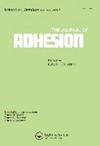Compliance Methods For Bonded Joints: Part II - Investigation Of The Equivalent Crack Methodology To Obtain The Strain Energy Release Rate For Mode I
IF 2.3
4区 材料科学
Q2 ENGINEERING, CHEMICAL
引用次数: 2
Abstract
ABSTRACT The present work investigates the equivalent crack methodology by considering the Double Cantilever Beam (DCB) test to obtain the strain energy release rate of adhesive joints, using different compliance methods rather than the Compliance Based Beam Model (CBBM). This procedure allows the determination of the crack length based on the compliance of the specimen, which avoids crack growth monitoring during tests. The compliance values predicted by the analytical methods were studied and compared with a computational model, considering different crack lengths. Results showed that the preciseness of the crack length obtained by the equivalent crack method relies on the accuracy of the respective compliance method in predicting the load-displacement curve of a bonded double cantilever beam. The Euler–Bernoulli and Timoshenko beam models are not recommended to obtain an equivalent crack length based on the specimen’s compliance since they overestimate the actual crack length. Best crack length predictions were obtained using compliance methods based on the beam-on-elastic foundation models, including an elastic interface to model the adhesive layer joint. Similar strain energy release rate results were found for different compliance methods when using the equivalent crack methodology.结合接头的柔度方法:第2部分-获得模一应变能释放率的等效裂纹方法的研究
摘要本文采用不同的柔度方法,而不是基于柔度的梁模型(CBBM),研究了考虑双悬臂梁(DCB)试验的等效裂纹方法,以获得粘接节点的应变能释放率。该程序允许根据试样的顺应性确定裂纹长度,从而避免在测试期间监测裂纹的生长。研究了分析方法预测的柔度值,并在考虑不同裂纹长度的情况下与计算模型进行了比较。结果表明,等效裂纹法计算裂缝长度的准确性依赖于相应柔度法预测粘结双悬臂梁荷载-位移曲线的准确性。由于Euler-Bernoulli和Timoshenko梁模型高估了实际裂缝长度,因此不建议根据试件的柔度来获得等效裂缝长度。基于弹性梁基础模型的柔度方法获得了最佳的裂缝长度预测,其中包括一个弹性界面来模拟粘接层接缝。当采用等效裂纹方法时,不同柔度方法的应变能释放率结果相似。
本文章由计算机程序翻译,如有差异,请以英文原文为准。
求助全文
约1分钟内获得全文
求助全文
来源期刊

Journal of Adhesion
工程技术-材料科学:综合
CiteScore
5.30
自引率
9.10%
发文量
55
审稿时长
1 months
期刊介绍:
The Journal of Adhesion is dedicated to perpetuating understanding of the phenomenon of adhesion and its practical applications. The art of adhesion is maturing into a science that requires a broad, coordinated interdisciplinary effort to help illuminate its complex nature and numerous manifestations.
 求助内容:
求助内容: 应助结果提醒方式:
应助结果提醒方式:


